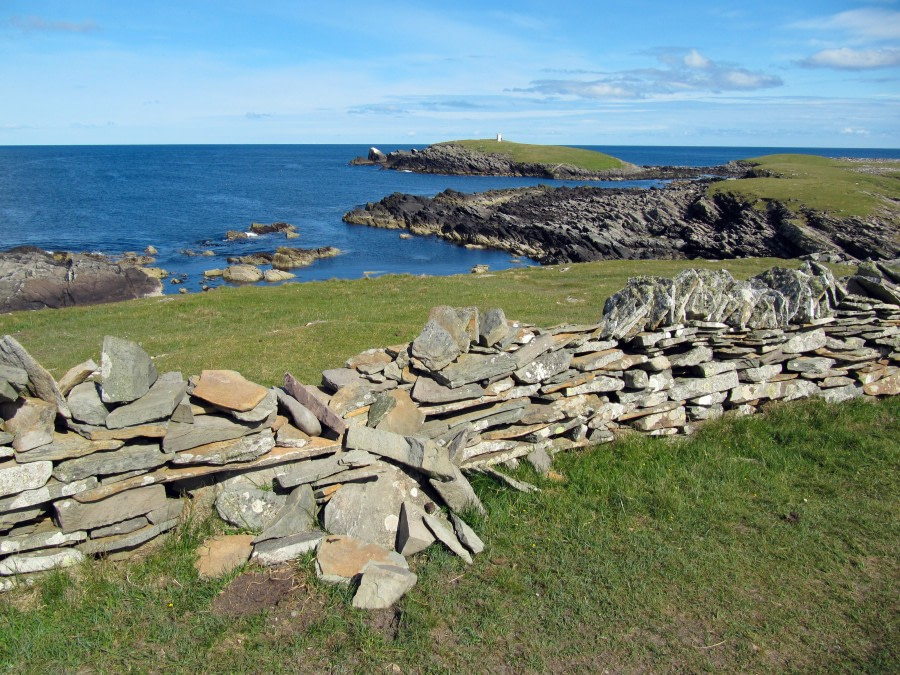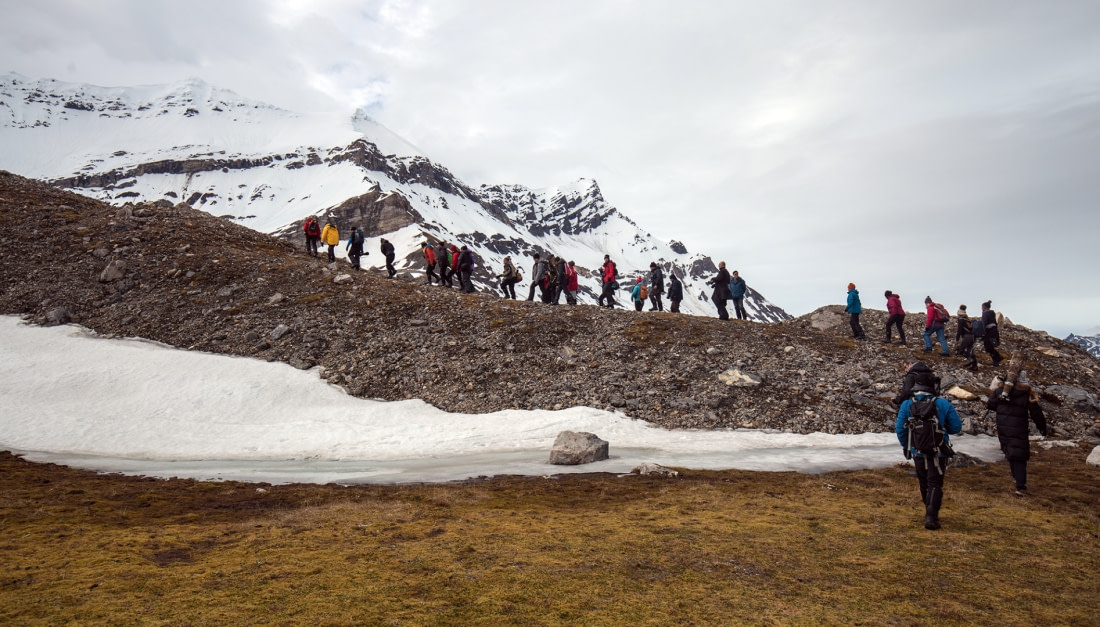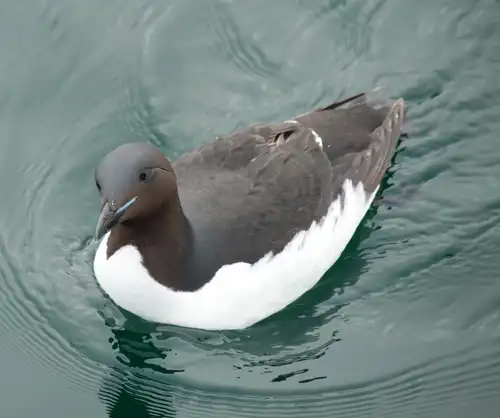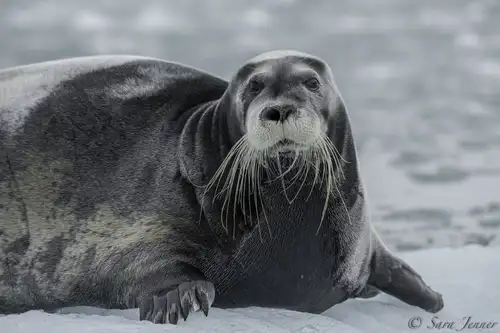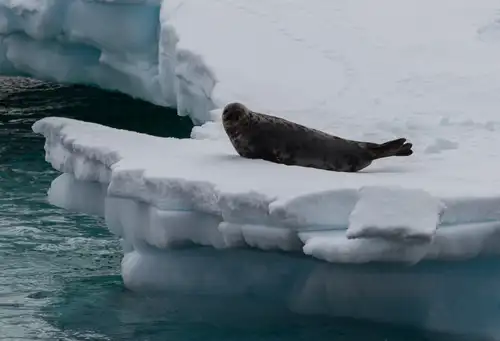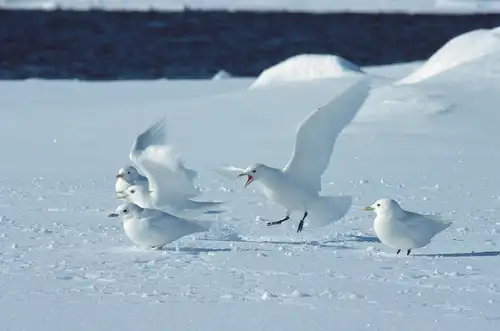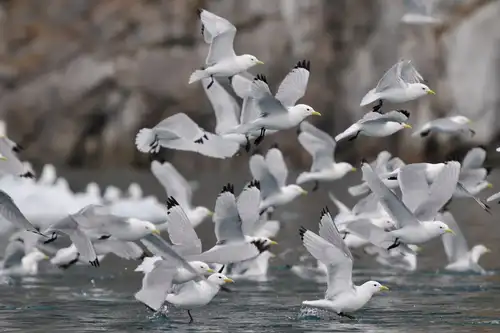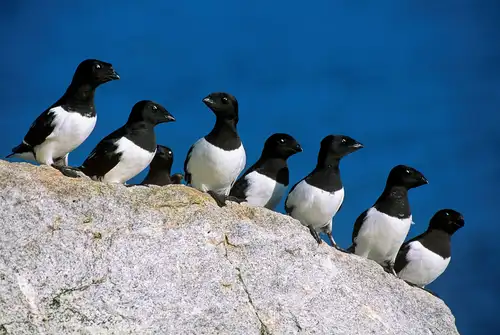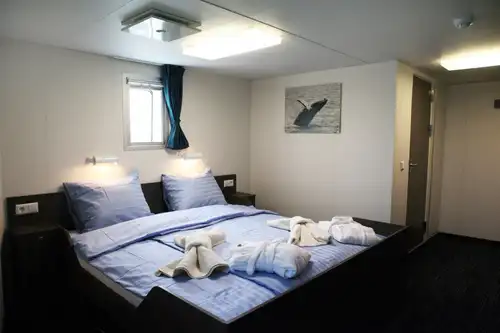

















































 10 Days/9 Nights
10 Days/9 Nights




Note: All itineraries are for guidance only. Programs may vary depending on ice, weather, and wildlife conditions. Landings are subject to site availabilities, permissions, and environmental concerns per AECO regulations.
We will have at least one dedicated expedition guide in our team who will share their expert knowledge about bird species and who will be available to help you identify, photograph on deck and learn more about the birds that we see. In addition to outdoor sessions, our guide will focus on species and related information on the birds of the Arctic in re-caps and lectures onboard.
Sights of the Granite City
You arrive in Aberdeen, the Granite City, frequent winner of the Britain in Bloom competition. This is the true start of your trip. Several cetaceans, including orcas (killer whales), are native to these seas. To the south you see the lighthouse on Girdle Ness that was designed by the grandfather of Robert Louis Stevenson, the famed Scottish writer who gave us such classics as Treasure Island and Dr. Jekyll and Mr. Hyde. More passengers join you in Aberdeen.
Birds, seals, and world-famous knits
We plan to stay the day on Fair Isle, an island in the Shetlands whose seventy-odd inhabitants are known for their beautiful knitwear. This is a fantastic location with accessible seabird breeding grounds, and you may even spot grey seals.
Jan Mayen marine life
You sail north to the Norwegian island of Jan Mayen, 300 nautical miles northeast of Iceland. Your two days at sea do not pass idly, however. Keep a close lookout for any spouts of water from the surrounding seas, heralding the arrival of a minke, fin, orca, or blue whale.
Snow-capped seaside volcano
Jan Mayen is a stark volcanic island crowned by the snow-capped summit of Mt. Beerenberg. From the slopes of this imposing 2,300-meter-high (7,545 feet) volcano, broken glaciers grasp out into the frigid sea. With permission from the Norwegian authorities, you can now visit the weather station. You can also walk to the remains of a 17th-century Dutch whaling station amid the thick moss beds of this stark volcanic landscape.
Under the midnight sun & along the ice edge
Basking in the midnight sun, you sail north along the edge of the sea ice in search of bowhead whales, harp seals, polar bears, and a variety of seabirds. You then change direction after about 79° north, cutting west to the rocky edges of the continental shelf of west Spitsbergen. Here you have a good chance of seeing fin whales and – near the glacial mouths of the gaping Spitsbergen fjords – surfacing minke whales.
The Arctic island of Spitsbergen
Forlandsundet, between the main island of Spitsbergen and the narrow Prins Karls Forland, is a place of great beauty and fascinating wildlife. Walruses sometimes haul out here. Alternatively, you might sail into St. Johns Fjord or head south to the mouth of Isfjorden, landing at Alkhornet. Seabirds nest on these cliffs, Arctic foxes search below for fallen eggs and chicks, and reindeer graze the sparse vegetation.
Journey’s end in Longyearbyen
Every adventure, no matter how grand, must eventually come to an end. You disembark in Longyearbyen, the administrative center of Spitsbergen, taking home memories that will accompany you wherever your next adventure lies. But if you’re still craving additional chances to spot the Arctic’s most iconic apex predator, stay on board for our seven-night North Spitsbergen Explorer - Versatile landscapes, sea ice & wildlife cruise.








































































m/v Ortelius
The ice-strengthened Ortelius is fully equipped for polar exploration and can accommodate helicopter flights when necessary.

Specifications
| Passengers: | 108 passengers in 50 cabins |
| Staff & crew: | Crew 44 | Guides 8 | Doctor 1 |
| Length: | 90.95 meters |
| Breadth: | 17.20 meters |
| Draft: | 5.4 meters |
| Ice class: | UL1 (Equivalent to 1A) |
| Displacement: | 4090 tonnes |
| Propulsion: | 6 ZL 40/48 SULZER |
| Speed: | 10.5 knots average cruising speed |
Cabins Gallery


Ship Interior Gallery


Ship Exterior Gallery


Ortelius was originally the Marina Svetaeva. Built in Gdynia, Poland in 1989, it served as a special-purpose vessel for the Russian Academy of Science. Later it was re-flagged and renamed after the Dutch/Flemish cartographer Abraham Ortelius (1527 – 1598), who in 1570 published the first modern world atlas: Theatrum Orbis Terrarum or Theater of the World. At that time his atlas was the most expensive book ever printed. Ortelius is classed by Lloyd’s Register in London and flies the Dutch flag.
Perfect for Any Expedition
The vessel has the highest ice-class notation (UL1, equivalent to 1A) and is therefore suitable to navigate in solid one-year sea ice as well as loose multi-year pack ice. Ortelius can accommodate up to 108 passengers and has an abundance of open-deck spaces. It is manned by 24 highly experienced nautical crew members, 20 hotel staff, eight expedition specialists (one expedition leader, one assistant, and six lecturer-guides), and one doctor.
Ortelius: a Vessel with Comfort and Character
Please be aware that a small number of cabins may have a partially obstructed view due to the size of the windows and the design requirements of the ship. For example, some windows may be partly obstructed in the lower half by a gangway. The best view is always on the outer deck or the bridge. Though our voyages are primarily meant to offer our passengers an exploratory wildlife program with as much time ashore as possible, Ortelius offers all the comforts of a standard hotel ― along with a bar and lecture room. Flexibility assures maximum wildlife opportunities. As such, Ortelius carries 10 Zodiacs with 60hp Yamaha engines.
What to Wear
In keeping with the spirit of expedition, dress on board is informal. Bring casual and comfortable clothing for all activities, and keep in mind that much of the scenery can be appreciated from deck ― which can be slippery. Bring sturdy shoes with no-slip soles, and make sure your parka is never far away in case one of our crew shouts “Whales!” over the loudspeaker and you have to dash outside in a moment’s notice. Opt for layers, as it is comfortably warm aboard the ship though often cold on deck.
How to Pay
Refreshments and souvenirs will be charged to your cabin. The day before departure you can settle your bill with the hotel manager, paying by credit card (Visa or MasterCard) or cash (euro, or in some cases dollar). We cannot, however, accept checks. Though the prices and standard currency on board is in the euro, other currencies may be accepted at the discretion of the hotel manager, at prevailing rates.
Electric Current
The electrical supply aboard ship is 220v, 60Hz. Electrical outlets are standard European with two thick round pins, so some passengers may need a 220v/110v converter.
Gratuities
The customary gratuity to the ship’s service personnel is made as a blanket contribution at the end of the voyage and is divided among the crew. Tipping is a personal matter, and the amount you wish to give is at your sole discretion. As a generally accepted guideline, we suggest 8 ― 15 euros per passenger per day. It is better for the crew if you give cash.
Non-Smoking Policy
We have a non-smoking policy inside all our vessels, though you can smoke in certain designated areas. We ask that you please respect the wishes of non-smokers.
Your Physical Condition
You must be in good overall health and be able to walk several hours per day. The expedition is ship-based and physically not very demanding, but we spend as much time as possible on shore. You are, however, welcome to remain aboard the ship if you prefer. To join most excursions you must be able to get up and down the steep gangway ― from the ship to the water level ― to board the Zodiacs. Staff will assist you in and out of the boats, and boarding will become progressively easier with practice, but conditions on shore can be slippery and rocky. Remember, you will be traveling in remote areas without access to sophisticated medical facilities, so you must not join this expedition if you have a life-threatening condition or need daily medical treatment.
- You need to be in good general health and able to walk several hours per day. Though our expeditions are ship-based, they can be physically demanding. You can choose to stay on the vessel if you prefer, but you will still need to be able to move safely around the ship even in bad weather. Assuming you choose to join landings, you will need to be able to get in and out of the Zodiacs. You must also be capable of getting up and down the gangway. This will become easier with practice, but the gangway is steep and moves with the rocking of the vessel. Conditions on shore can also be rocky, uneven, and slippery, and we will be in remote areas without access to sophisticated medical facilities. You must not join an expedition if you have a life-threatening condition or need daily medical treatment. Any major health problem or physical condition that requires emergency care must be brought to our attention prior to the voyage. Please fill out our Personal Information Form, which we will send at the time of booking. This form must be completed and returned within one month of your book date. Since we travel in such remote areas, medical evacuation by air is often impossible. We therefore reserve the right to refuse travel or participation in activities to anyone whose health concerns might pose a safety risk to our staff or other passengers.
- Yes, an overriding concern is the protection of the wildlife, environment, and cultures in all of the areas we visit. We will address conservation issues in the onboard briefings, and the expedition staff will assist you on shore. We are members of IAATO and AECO and will abide by their guidelines. We will also follow all local requirements to minimize our impact on the environment and wildlife. When in doubt, remember our two most important rules: Do not leave anything but footprints Do not take anything but memories
- The currency used on all vessels is the Euro, but you can also pay with USD.
- No, you are not able to get cash advances on the vessel.
- The weather in Spitsbergen differs per area and location. Although snow can occur throughout the year in Svalbard, the North Atlantic Current helps provide Svalbard with warmer temperatures than many other areas within similar latitudes. However, strong winter breezes, low pressure and the combination of wet sea air and cold polar air can lead to rapidly changing weather conditions, especially during the winter months. During the winter season, the temperature in Spitsbergen can can drop to -16 to -12 degrees Celsius (3 to 10 degrees Fahrenheit). Adding in the wind chill factor means the weather can feel much colder. July is the warmest month of the year with an average temperature between 3 and 8 degrees Celsius (37 to 46 degrees Fahrenheit). We therefore recommend that you bring a variety of warm clothes for your Spitsbergen cruise.
- Svalbard is part of the non-mainland Norwegian islands. This West Spitsbergen island was first spotted in 1596 by Wilhelm Barents, and it was originally claimed by the Danish. The Spitsbergen Treaty granted Norway sovereignty over Spitsbergen as of 1920, but anyone who is a citizen of the more than 40 signatory nations has the legal right to settle within Spitsbergen.
- The Ortelius was built in Poland in 1989 for the Russian Academy of Science.
- There are in total 50 cabins at the Ortelius. 4 quadruple cabins with bunk beds. 26 twin porthole cabin with 2 single berths. 12 twin cabins with windows and 2 lower berths. 2 twin deluxe cabins with windows and 2 single lower berths. 6 superior cabins with double beds. All cabins are spacious outside cabins with a minimum of two portholes or windows per cabin and all cabins have a private shower and toilet.
You May Also Like



Alpine Peaks of Spitsbergen, Ski & Sail
 8 Days / 7 Nights
8 Days / 7 Nights

Arctic Ocean - Fair Isle, Jan Mayen, Ice Edge, Spitsbergen, Birding
 10 Days / 9 Nights
10 Days / 9 Nights
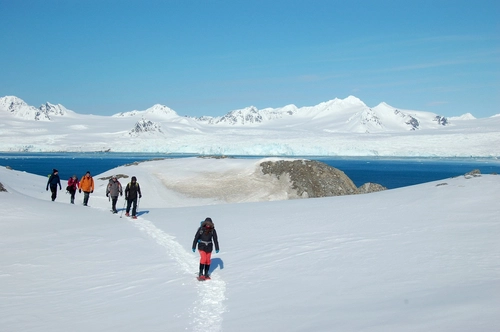
North Spitsbergen - Arctic Spring , Hike & Sail
 8 Days / 7 Nights
8 Days / 7 Nights

North Spitsbergen Explorer - Into the pack ice - Polar Bear Special
 8 Days / 7 Nights
8 Days / 7 Nights

Arctic Ocean - Jan Mayen, Ice edge, Spitsbergen, Birding
 9 Days / 8 Nights
9 Days / 8 Nights

Arctic Ocean - Fair Isle, Jan Mayen, Ice edge, Spitsbergen, Birding - Summer Solstice
 10 Days / 9 Nights
10 Days / 9 Nights

North Spitsbergen Explorer - Versatile landscapes, sea ice & wildlife
 8 Days / 7 Nights
8 Days / 7 Nights

North Spitsbergen Basecamp – Summer Solstice - Free Kayaking, Hiking, Photo Workshop, Diving (supplemented)
 8 Days / 7 Nights
8 Days / 7 Nights

North Spitsbergen Explorer - Versatile landscapes, sea ice & wildlife - Summer Solstice
 8 Days / 7 Nights
8 Days / 7 Nights

North Spitsbergen - Arctic Summer
 11 Days / 10 Nights
11 Days / 10 Nights

East Spitsbergen - Home of the Polar Bear, Including Long Hikes & Cleaning the Shores
 8 Days / 7 Nights
8 Days / 7 Nights

Around Spitsbergen, In the realm of Polar Bear & Ice
 10 Days / 9 Nights
10 Days / 9 Nights

North Spitsbergen Explorer – Into the Pack Ice – Polar Bear & Whale Special
 10 Days / 9 Nights
10 Days / 9 Nights

Northeast Greenland Solar Eclipse Explorer Voyage
 14 Days / 13 Nights
14 Days / 13 Nights

Spitsbergen - Northeast Greenland, Fly & Sail
 20 Days / 19 Nights
20 Days / 19 Nights

Around Spitsbergen incl. Nordaustlandet
 10 Days / 9 Nights
10 Days / 9 Nights

Alpine Peaks of Spitsbergen - Ski & Sail
 8 Days / 7 Nights
8 Days / 7 Nights

Arctic Ocean - Fair Isle, Jan Mayen, Ice Edge, Spitsbergen, Birding Special
 10 Days / 9 Nights
10 Days / 9 Nights

North Spitsbergen Explorer - Versatile Landscapes, Sea Ice & Wildlife
 8 Days / 7 Nights
8 Days / 7 Nights

North Spitsbergen Explorer - Into the Pack Ice - Polar Bear Special
 8 Days / 7 Nights
8 Days / 7 Nights

North Spitsbergen, Arctic Summer - Summer Solstice
 11 Days / 10 Nights
11 Days / 10 Nights

North Spitsbergen Explorer - Versatile Landscapes, Sea Ice & Wildlife - Summer Solstice
 8 Days / 7 Nights
8 Days / 7 Nights

North Spitsbergen Explorer - Into the Pack Ice - Polar Bear Special - Summer Solstice
 8 Days / 7 Nights
8 Days / 7 Nights

Arctic Ocean - Spitsbergen: Jan Mayen, Ice Edge & Birding - Summer Solstice
 9 Days / 8 Nights
9 Days / 8 Nights

North Spitsbergen Basecamp - Free kayaking, Hiking, Photo Workshop
 8 Days / 7 Nights
8 Days / 7 Nights

North Spitsbergen, Arctic Summer
 11 Days / 10 Nights
11 Days / 10 Nights

Around Spitsbergen, in the Icy Realm of the Polar Bear
 10 Days / 9 Nights
10 Days / 9 Nights

A Taste of North Spitsbergen - Compact Arctic Adventure
 6 Days / 5 Nights
6 Days / 5 Nights

South Spitsbergen Explorer - Bear Island - Diving (supplemented)
 10 Days / 9 Nights
10 Days / 9 Nights

Around Spitsbergen - Arctic Summer
 15 Days / 14 Nights
15 Days / 14 Nights

Around Spitsbergen and Nordaustlandet, In the Icy Realm of the Polar Bear
 10 Days / 9 Nights
10 Days / 9 Nights

Spitsbergen, Northeast Greenland & Scoresby Sund, Including Long Hikes
 14 Days / 13 Nights
14 Days / 13 Nights

South Spitsbergen, Bear Island & Mainland Norway - Aurora Borealis
 6 Days / 5 Nights
6 Days / 5 Nights

The Enchanting Islands of Svalbard

Inside the Svalbard Global Seed Vault

Polar Bear Sets Impressive New Diving Record

Polar bear feast

Polar Bear Primer: Eight Facts About the Arctic Wanderer

Svalbard vs. the Canadian Arctic

Birding Opportunities Abound in Spitsbergen

Eight Engaging Reindeer Facts

A Bug’s Life in Svalbard

The Ins, Outs, and Ups of Polar Mountaineering & Ski Mountaineering

15 Toothy Facts About the Atlantic Walrus

Around Spitsbergen vs. North Spitsbergen

The Northern Lights dancing across the skies

Polar bear encounter in Spitsbergen

Amphibian, reptiles and herbivore mammals in the Arctic

Arctic Icon: 10 Facts about the Polar Bear

The Arctic’s Most Phenomenal Fjords

“The polar bear will still be there”

What’s so Special about East Spitsbergen?





